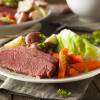When I say “Thanksgiving,” what image pops into your mind? You might picture your family sitting around a long table laden with food, or that time your grandmother ate the entire bowl of gravy thinking it was soup (true story: she said it was good, but a little salty, and laughed along with us once she realized her mistake).
And what about the “First Thanksgiving”? The one you were taught about in grade school, complete with Pilgrims in black hats with buckles and Native people in deerskin, harmoniously feasting on corn, turkey and squash. The scene wouldn’t be complete, of course, without a cornucopia (the horn of plenty!) adorning the center of the table.
Well, I’m about to blow your holiday-loving mind. That image you have of the first Thanksgiving? It’s almost certainly, for the most part, a myth.
By the time the Pilgrims settled in Plymouth Colony, it was common practice for a local authority figure to declare days of thanksgiving. For example, King James declared November 5th an annual day of thanksgiving to commemorate the failed attempt to blow up Parliament in 1605 (commonly known as the Gunpowder Plot). William Bradford, the governor of Plymouth Colony, declared a day of thanksgiving in August of 1623, which, over time, got conflated with a celebration of the Pilgrims’ first harvest in 1621.
Back then, days of thanksgiving were strictly religious and involved more fasting than feasting. So much for our naive notion of Thanksgiving being about peace, love and turkey…
But wait—some aspects of what you were taught are true! Both the Pilgrims and Wampanoag traditionally celebrated a bountiful harvest by giving thanks. This likely included a feast of venison, fowl, fish, shellfish and maybe some vegetables, nuts and berries (sorry—no cranberry sauce!).
Fast forward a century or so and most of the colonies in New England were annually declaring a Thursday in late November/early December a thanksgiving holiday. But it wasn’t really until the Victorian era that it turned into what we think of as Thanksgiving today, complete with big family gatherings, roasted turkey and—perhaps most importantly—pie.

Abraham Lincoln declared Thanksgiving a national holiday in 1863 thanks in large part to the persistence of Sarah Josepha Hale, an American writer who argued it was as important a celebration of the American identity as the Fourth of July. By the late 1800s, Thanksgiving preparations in a typical New England household took over a week. Sound familiar?
Across the region, pie closet shelves—yes, they dedicated a specially designed closet just to storing pies—groaned under the weight of every type imaginable: mince, apple, chicken, pumpkin, cranberry and plum. The Marlborough pie, a Massachusetts specialty featuring apples and lemon custard, was especially popular.
Thanksgiving tables featured local ingredients served in creative ways. Plump oysters were used to make stuffing and sauces, wild game was roasted and presented whole, pickles and preserves were always within arm’s reach and there was plenty of wine, ginger beer and cider on hand to wash it all down. The company was equally important; friends and family traveled great distances to be with their loved ones on the special day. And, yes, there was usually a kids’ table (looks like we can thank our Victorian ancestors for that humiliating invention).
The way we celebrate Thanksgiving hasn’t changed much since then. We still travel great distances to spend the day with friends and family. Our tables are laden with hearty fare that echoes the shades of autumn—golden squash, green beans, orange yams—and roasted turkey remains the star of the show. The meal usually ends with a few types of pie and expressions of gratitude. It’s nice to know that some things haven’t changed since the time of Honest Abe. And to think, it all started right here in our little Northeast corner of the nation. When you trace it back to its beginning, Thanksgiving is really about celebrating New England’s unique history—pumpkin pie included—which is just one more thing to be thankful for.




